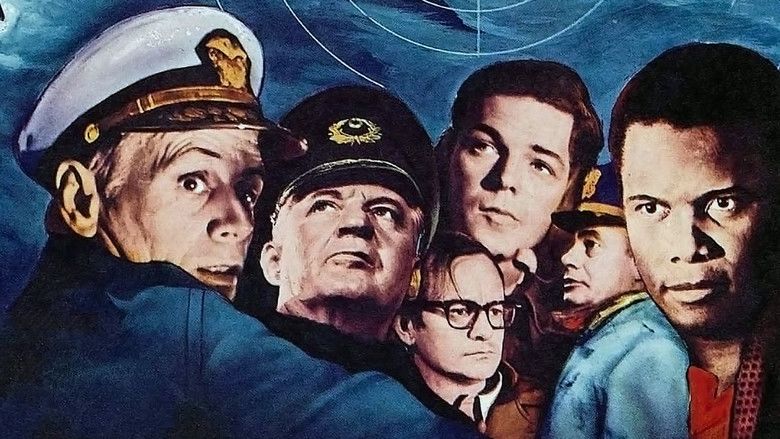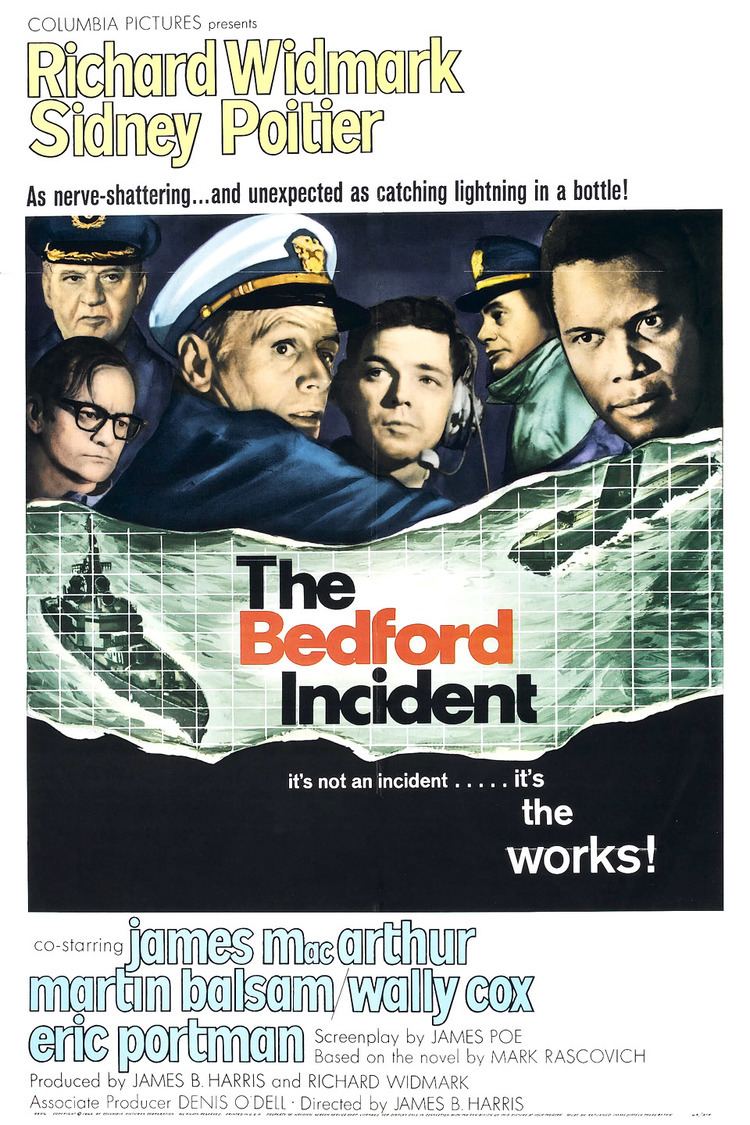The Bedford Incident
8 /10 1 Votes
86% Rotten Tomatoes Genre Drama, Thriller Music director Gerard Schurmann Country United KingdomUnited States | 7.5/10 IMDb Initial DVD release September 23, 2003 Duration Language English | |||||||||||||||||||||||||||||||||
 | ||||||||||||||||||||||||||||||||||
Release date 11 October 1965 (1965-10-11) Based on The Bedford Incident1963 novel by Mark Rascovich Cast (Captain Eric Finlander, U.S.N.), (Ben Munceford), (Commodore Wolfgang Schrepke, Deutsche Marine), (Ensign Ralston, U.S.N.), (Lieut Cmdr. Chester Potter, M.D., U.S.N.), (Seaman Merlin Queffle) Similar movies Das Boot , The Hunt for Red October , The Spy Who Loved Me , The Big Sleep , Double Indemnity , The Asphalt Jungle | ||||||||||||||||||||||||||||||||||
The Bedford Incident is a 1965 Anglo-American Cold War film starring Richard Widmark and Sidney Poitier and coproduced by Richard Widmark. The cast also features Eric Portman, James MacArthur, Martin Balsam and Wally Cox, as well as early appearances by Donald Sutherland and Ed Bishop. The screenplay by James Poe is based on the 1963 book by Mark Rascovich. That, in turn, was patterned after Herman Melville's Moby-Dick; at one point in the film, the captain is advised he is "not chasing whales now".
Contents

The film was directed by James B. Harris, who, until then, was best known as Stanley Kubrick's producer.

Trailer the bedford incident 1965
Plot
The American destroyer USS Bedford (DLG-113) detects a Soviet submarine in the GIUK gap near the Greenland coast. Although the U.S. and the Soviet Union are not at war, Captain Eric Finlander (Richard Widmark) harries his prey mercilessly while civilian photojournalist Ben Munceford (Sidney Poitier) and NATO naval advisor Commodore (and ex-Second World War U-boat captain) Wolfgang Schrepke (Eric Portman), look on with mounting alarm.
Because the submarine is not powered by a nuclear reactor, its submerged run distance is limited, critical when it also needs breathing air and to recharge its batteries. This gives Finlander an advantage but also means the Soviets will be more desperate. Also aboard the ship are Ensign Ralston (James MacArthur), an inexperienced young officer constantly being criticised by his captain for small errors, and Lieutenant Commander Chester Potter, USNR (Martin Balsam), the ship's new doctor, who is a reservist recently recalled to active duty.
Munceford is aboard in order to photograph life on a Navy destroyer, but his real interest is Captain Finlander, who was recently passed over for promotion to rear admiral. Munceford is curious whether a comment made by Finlander regarding the American intervention in Cuba is the reason for his nonpromotion, perhaps betraying veiled aggression. Munceford is treated with mounting hostility by the captain because he is seen as a civilian putting his nose where it does not belong and because he disagrees with Finlander's decision to continue with an unnecessary and dangerous confrontation. Finlander is hostile to anyone who is not involved in the hunt, including the doctor, who will not stand up to the captain but advises that the pressure on the crew be reduced.
The crew becomes increasingly fatigued by the unrelenting pursuit during which the captain demands full attention to the instruments. When the submarine is found and ignores Captain Finlander's demand to surface and identify itself, Finlander escalates the situation by smashing into the submarine's snorkel, calling it "floating debris". Finlander then orders the Bedford to arm weapons and withdraw a distance, where he will wait for the submarine's crew to run out of air and be forced to surface. He reassures Munceford and Schrepke that he is in command of the situation and that he will not fire first, but "If he fires one, I'll fire one."
A tired Ensign Ralston mistakes Finlander's remark as the command to "fire one!" and launches an anti-submarine rocket. The crew attempts to immediately disarm its warhead and they wait anxiously as the rocket flies to its targeted locating and plunges below the surface toward the submarine. Several seconds later, their hopes are dashed as the warhead detonates, destroying the submarine. Sonar then detects four Soviet nuclear-armed torpedoes are targeting the destroyer; the submarine had fired them as soon as it detected the rocket's entry into the water. Finlander initially gives basic orders to evade but then silently steps outside. Munceford follows, frantically pleading with the captain to do something.
Instead Finlander does nothing, knowing his actions have doomed everyone on board the Bedford, as the ship cannot escape the nuclear torpedoes. The film ends with still shots of various crewmen "melting" as if the celluloid film were burning as the Bedford and her crew are vaporised in an atomic blast. The film's final image is an iconic, towering mushroom cloud.
Cast
Writing
The screenplay by James Poe follows the novel fairly closely. However, Poe wrote a completely different ending for the film. In the novel, the Soviet submarine does not fire back at Bedford before being destroyed. The shocked Finlander then receives word of his promotion to admiral. Commodore Schrepke, realising the catastrophic consequences once the events are known, sabotages one of the remaining ASROCs and destroys the ship. Munceford, the sole survivor, is found by Novosibirsk, the submarine's mothership. Unlike the book, the film version ends with the vessels being destroyed by one another.
The plot reflects several actual Cold War incidents of tense stand-offs between NATO and Soviet navies, including one in 1957 when USS Gudgeon, a U.S. submarine, was caught in Soviet waters and chased out to sea by Soviet warships. Although none ended as catastrophically as the Bedford incident, the story illustrated many of the fears current at the time.
Similar plot devices have been used in later submarine based films, including Crimson Tide and The Hunt for Red October.
Filming
The Bedford Incident was mostly filmed at Shepperton Studios in the UK although some shots at sea were used. "USS Bedford" was a fictitious guided missile destroyer, and the role of Bedford was mostly played by a large model of a Farragut-class destroyer. Interior scenes were filmed in the British Type 15 frigate HMS Troubridge; British military equipment can be seen in several shots, including a rack of Lee–Enfield rifles, and Troubridge's novel forward-sloping bridge windows. Sidney Poitier's initial flypast and landing from a Whirlwind helicopter were filmed aboard another Type 15 frigate, HMS Wakeful, whose F159 pennant number is clearly visible.
The vessel portraying a Soviet intelligence ship has the name "Novo Sibursk", written on the hull at the bow in the Roman alphabet, not the Russian language's Cyrillic alphabet. "Novosibirsk" is a more accurate English rendering.
Actual Cold War incident
In October 1962, shortly before the start of the Cuban Missile Crisis, the Soviet submarine B-59 was pursued in the Atlantic Ocean by the U.S. Navy. When the Soviet vessel failed to surface, the American destroyers began dropping training depth charges. However, unlike in The Bedford Incident, the Americans were not aware that the B-59 was armed with a T-5 nuclear torpedo. The Soviet captain, believing that World War III might have started, wanted to launch the weapon. However, his flotilla commander, Vasili Arkhipov, who by happenstance was using the boat as his command vessel, refused to endorse the command. After an argument, it was agreed that the submarine would surface and await orders from Moscow. It was not until after the fall of the Soviet Union that the weapon's existence and how close the world came to nuclear conflict was made known.
References
The Bedford Incident WikipediaThe Bedford Incident IMDbThe Bedford Incident Rotten TomatoesThe Bedford Incident themoviedb.org
